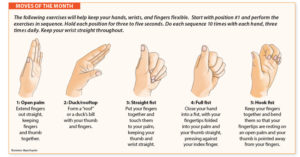Keep Wrists and Hands Injury-Free
There are more than 30 muscles, 27 bones, three nerves, and multiple ligaments and tendons in our hands and wrists. They are such a vital part of our daily routine that we don’t even realize how much we use them until they become injured.
Unfortunately, injuries to the wrist and hand are fairly common. They can happen from a slip and fall as we put our hands out to catch ourselves—one of the most common reasons for injury—or even from lifting everyday things the wrong way. Hands and wrists also can become sore from overuse—for example, too many hours gardening—and can stiffen with age, which increases their risk of injury. With exercise, however, you can keep your wrists and hands supple and less prone to injury.
“The most common diagnosis we see is a wrist fracture,” says Nicholas Maroldi, a doctor of physical therapy and an orthopedic clinical specialist and hand specialist at the Weill Cornell-affiliated Hospital for Special Surgery. “These typically occur from a fall on an outstretched hand, which could happen at home, or from tripping on a sidewalk.”
Elbow fractures also are common injuries from falls, he says, followed by mallet fingers, which occur from jamming the tip of a finger against something, which ruptures the terminal extensor tendon from its connection to the bone. “This presents as a drooping fingertip that will not extend fully on its own,” Maroldi explains.
Common non-traumatic diagnoses include carpal tunnel syndrome, which causes numbness and tingling in the thumb and fingers, and lateral and medial epicondylitis—inflammation of the inside of the elbow.
Reducing Injury Risk with Exercise
Maroldi’s first advice is to strengthen your lower body. “To reduce your chances of falling and suffering a traumatic injury to the hand or wrist, it’s important to maintain adequate lower-extremity strength and endurance,” Maroldi says. “Aerobic conditioning and balance training also are very important to help reduce fall risk.”
Exercise is the first line of defense against osteoarthritis. “General exercise can have a profound effect on the symptoms, and although the arthritis will not go away, it is very possible to reduce pain and improve function,” Maroldi says. “Specific exercises that teach motor control and proper joint mechanics (joint movement) can be helpful to avoid excessive stress through the joint and improve stability.”
Exercise also is important if you have rheumatoid arthritis, but care needs to be taken, he says, not to push through pain or flare-ups. “Grip-strengthening exercises can cause more inflammation and deformity. Splinting, proper joint protection and mechanics are critical to maintain function and reduce pain.”
The post Keep Wrists and Hands Injury-Free appeared first on University Health News.

